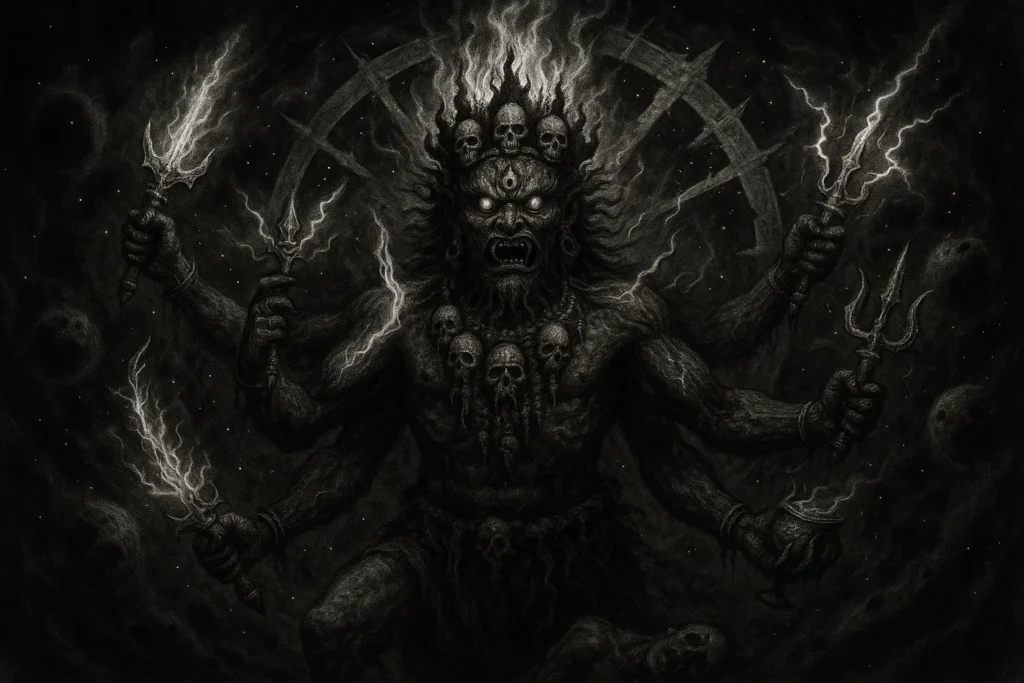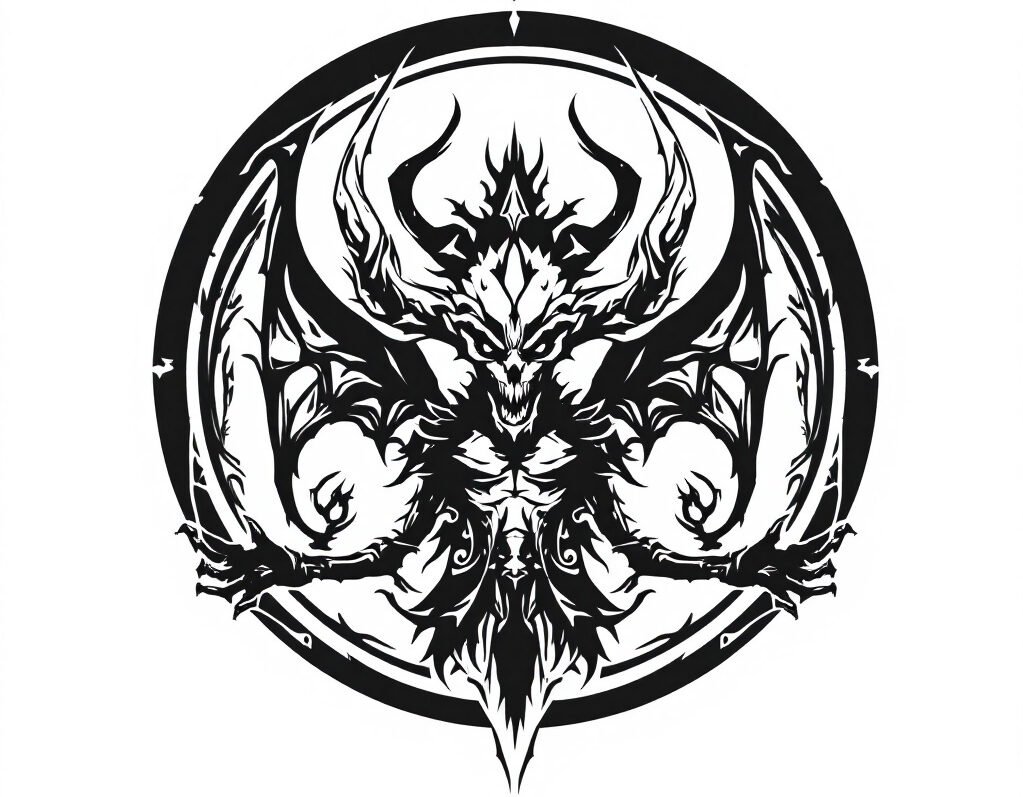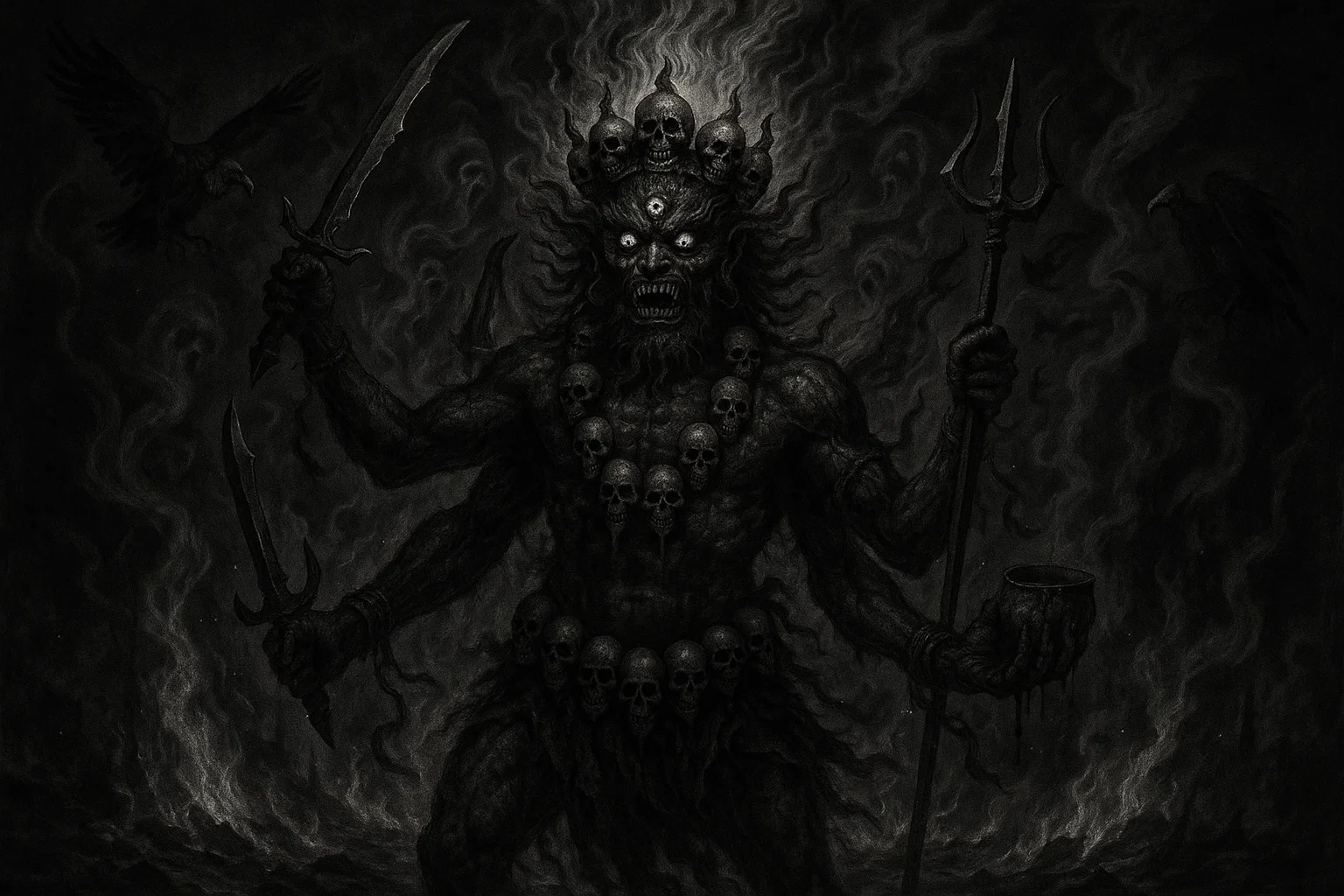Mahakala is a significant entity in Buddhist traditions, revered for his role as a protector of the teachings. He appears as a wrathful deity who fights against threats to the path of awakening.
His name means “Great Black One,” and he shows up in various forms across different schools of Buddhism. People turn to him for safety from harm and help in overcoming barriers on their spiritual journey.
This entity also links to Hindu beliefs, where Mahakala serves as a fierce form of the god Shiva. For more details on his role in Hindu stories, check the Hindu Demons category.
Summary
Key Takeaways
| Attribute | Details |
|---|---|
| Names | Mahakala, Great Black One, Nakpo Chenpo (Tibetan), Daheitian (Chinese), Daikokuten (Japanese), Daeheukcheon (Korean), Dai Hac Thien (Vietnamese). |
| Title | Protector of the Dharma, Great Black Deity, God of Time. |
| Region | Tibet, India, China, Japan, Korea, Nepal, Mongolia. |
| Type | Dharmapala (protector deity), wrathful manifestation. |
| Gender | Male. |
| Realm | Cremation grounds, Buddhist monasteries; beyond standard realms as a destroyer at the end of cycles. |
| Obstacle/Threat | Destroys barriers to enlightenment, such as evils, demons, and threats to the teachings. |
| Associated Figures | Avalokiteshvara, Shiva, Hevajra, Vajradhara, Amitabha, Akshobhya, Manjushri, Vairocana. |
| Weapon/Item | Sword, trident, drum, scythe, hammer, skull cup. |
| Weaknesses | None documented. |
| Associated Deity/Figure | Buddhas like Avalokiteshvara (compassionate form). |
| Pantheon | Buddhist (Vajrayana, Mahayana), with Hindu influences. |
| Primary Sources | Guhyasamaja Tantra, Chakrasamvara Tantra, Humane King Sutra, Mahavairocana Tantra, Mahamayuri Vidyarajni Sutra, Shaktisamgama Tantra. |
“Mahakala” Meaning
The name “Mahakala” originates from the Sanskrit words “maha,” meaning great, and “kala,” which can refer to time, death, or darkness. Thus, it points to a being that transcends time or acts as a powerful force of change.
In Buddhist views, this name signifies his power to end cycles and dispel negative forces. Over time, as Buddhism spread, the name changed in different places.
In Tibet, people refer to him as Nakpo Chenpo, which translates to “Great Black One.” This fits his dark look and strong role.
In China, he goes by “Daheitian,” keeping the idea of a great black god.
Japan uses “Daikokuten,” associating him with luck and prosperity.
Finally, Korea has “Daeheukcheon,” and Vietnam calls him “Dai Hac Thien.”
These shifts demonstrate how local cultures incorporated the figure while retaining their core ideas. His roots are tied to older Indian beliefs, where kala is associated with time and the end of times.
However, in Buddhism, it evolved to emphasize the protection of the teachings. Historians observe this change as Buddhism merged with other traditions, such as during the Tang Dynasty in China or during its spread to Tibet.
How to Pronounce “Mahakala” in English
Say it as “mah-ha-kah-la,” with stress on the first and third parts.
In Chinese, Daheitian sounds like “dah-hay-tee-en.”
For Japanese Daikokuten, it’s “die-ko-koo-ten.” Korean Daeheukcheon goes “day-huhk-cheon.”
What Does Mahakala Look Like?
Mahakala is typically depicted in a frightening form to ward off evil forces. He has dark blue or black skin, which encompasses all colors and represents the full truth.
Often, he has three eyes that see the past, the present, and the future. His hair stands on end, and he wears a crown of five skulls—these symbolize the transformation from negative emotions to wisdom. A string of 50 heads hangs around his neck, linking to pure words and sounds. He sits on dead bodies, meaning he beats ego and wrong views.
In different arms—two, four, or six—he holds tools like a sword (to cut false ideas), a trident (to pierce bad habits), and a drum (to call good forces). Ashes from burning grounds cover him, and birds like vultures or jackals circle him.
In Tibetan ways, he looks fierce and stands tall. But in Japan, as Daikokuten, he smiles with a wide face, wears a flat black hat, and holds a gold hammer. He sits on rice bags with mice nearby for plenty.
Chinese views mix both: sometimes fierce, warding off bad energy, or serving as a kitchen guard. These changes stem from local needs—Tibet requires strong protection, while Japan seeks good fortune.
You may also enjoy:
Who Is Agaliarept, the General of Hell Under Lucifer?
October 8, 2025
What Is the Abumi-guchi Yōkai and Why Does It Wait Forever?
October 22, 2025
The Ghul: The Flesh-Eating Demon of Arabian Folklore
October 1, 2025
Bali: The Benevolent Asura King of Hindu Mythology
October 10, 2025
Marid: The Ocean Jinn That Defies Heaven and Earth
September 30, 2025
Rāga: The Seductive Demon of Passion and Desire in Buddhist Lore
October 16, 2025
Origins
Mahakala is a figure that originates from ancient Indian texts as a form of Shiva—known as the Destroyer in Hindu beliefs. He represents the way time can bring things to an end.
As Buddhism started to develop in India around the 7th century, Mahakala’s role changed. He became renowned as a guardian of the Buddhist teachings. Early Buddhist monks viewed him as a protector, and travelers like Yijing noted that images of Mahakala were often found in kitchens, where they kept bags for food gifts.
By the time of the Tang Dynasty in China, people began to chant mantras to invoke Mahakala’s aid in warding off harmful spirits (typically the malevolent female spirits known as dakinis).
In Tibet, he became an important figure in certain schools of Buddhism (particularly the Kagyu and Nyingma). Influential teachers from India (such as Khyungpo Nenjor) helped introduce him to Tibetan practice, and the hidden teachings known as terma also expanded his character.
During the Yuan Dynasty, Kublai Khan and other Mongol leaders adopted Mahakala as their protector. Statues from regions like Bihar and Odisha in India showcase how he was portrayed in early Buddhist art, dating back to the 11th and 12th centuries.
Mahakala’s character evolved through the use of tantric practices, where his fierce energy was seen as a way to remove obstacles. While he kept some connections to his Hindu origins, in Buddhism, he became a force for good.
Over time, he merged with other benevolent deities in East Asia, including those in Japan. As the centuries passed, his image spread widely, from the art of the Pala period to bronze sculptures during the Qing Dynasty.
Regional Variations
Mahakala adapts across Buddhist lands, aligning with local needs and perspectives. In some places, he stays fierce; in others, he turns kind.
| Region/Tradition | Appearance | Role |
|---|---|---|
| Tibetan Vajrayana | Black skin, multiple arms, skulls, flames in hair, three eyes. | Guards teachings, destroys threats to monks and paths. |
| Chinese Mahayana | Fierce, dark, sometimes with bag; less arms. | Kitchen protector, aids fertility, eats bad energy. |
| Japanese Shingon | Smiling, wide face, black hat, gold hammer, on rice bags. | Brings wealth, guards homes, one of lucky gods. |
| Indian Theravada influences | Dark, scary, linked to elephants as forms. | Temple guard, ends cycles, shared with Hindu sites. |
| Mongolian Gelug | White six-armed, upright or dancing. | Popular protector, grants wishes, fights evils. |
Buddhist Cosmology
In Buddhist views, Mahakala sits outside the six realms but acts in them all. He links to the end of kalpas—big time cycles—where he breaks down the world into nothing.
As a dharmapala, he guards the teachings from harm in the realms of desire, form, and no-form. He punishes the gods and the demons who fail, standing as time’s force.
Mahakala in Mahayana Sutras
In Mahayana texts, Mahakala serves as a powerful guardian who wards off threats and helps preserve the teachings. He appears in tantric forms, linked to Buddhas such as Vairocana. His role expands in later sutras.
| Source | Quote |
|---|---|
| Humane King Sutra | In that tale, a master tells Prince Kalmasapada to give one thousand kings’ heads to the great black god of the graveyard to gain the throne. |
| Mahavairocana Tantra | The manifestation of Vairocana swallows the flesh-eating female demons and lets them go only if they eat hearts of those near death. |
| Mahamayuri Vidyarajni Sutra | Call on Mahakala in the dharani to guard against harms and evils. |
Mahakala in Chinese or Korean Folklore
Mahakala plays a significant role in Chinese folklore as a fierce deity who guards monasteries and assists in daily life. In Korea, he appears less but follows similar ideas.
| Source | Quote |
|---|---|
| Yijing’s Records | In monasteries, a wooden figure of the deity with a golden bag stands in kitchens; monks offer food and incense to him. |
| Song Dynasty Tales | Moheluo dolls, from his name, are used in festivals for childbirth and to find partners. |
You may also enjoy:
Who Is Jann in Islamic Mythology and Why Is He Feared?
October 2, 2025
Who Is Abaddon, the Demon of the Abyss, in the Bible?
September 29, 2025
Bali: The Benevolent Asura King of Hindu Mythology
October 10, 2025
Who Is Agaliarept, the General of Hell Under Lucifer?
October 8, 2025
Banasura: The Thousand-Armed Demon King
October 10, 2025
Abadir: The Demon Servant of Chaos and Dispersion
September 30, 2025
Powers and Abilities
Mahakala holds high power among protectors, stronger than many demons or gods who fail against big evils. He outranks figures like the dakini or minor threats, acting as the last line of defense when others can’t. His strength matches Yamantaka and other top dharmapalas.
Mahakala’s powers and abilities include:
- He can break down the universe when a universal cycle comes to an end.
- He punishes and controls flesh-eating demons.
- Guards monasteries and kitchens from harm.
- Changes bad feelings into wisdom.
- Grants wishes and brings luck (in some forms). He can also fulfill prayers for those who follow the teachings.
- He devours the vital force of sinners.
- He can bring wealth and plenty (primarily in East Asian lore).
Mahakala Myths, Legends, and Stories
Subjugation of the Dakini
A version of the Buddha Vairocana appeared as Mahakala to deal with the dakini—female spirits known for being troublesome and consuming flesh. These spirits were causing chaos by draining the life force of others. In response, Mahakala swallowed them whole.
However, he later released them with one important rule: they could only take hearts from people who were already near death. This way, he managed to transform their harmful behavior into something more controlled.
The dakini agreed to this condition and stopped causing widespread harm.
The Tale of Prince Kalmasapada
In a faraway land, there was a prince named Kalmasapada who was eager to claim the throne. He encountered a deceptive teacher who tricked him into believing that if he offered the heads of a thousand kings to Mahakala, a powerful dark god associated with the graveyard, he would gain immense power.
Driven by this misguided advice, the prince set out on a gruesome mission to collect the heads.
However, before he could complete his task, he received guidance from wise and true teachings that helped him see the error of his ways. In the end, the prince chooses the right path, learns from his mistakes, and finds a way to win through goodness rather than violence.

Mahakala and the End of Cycles
At the end of each vast cycle of existence (known as a kalpa), powerful deities and creators, including the revered Trimurti, attempt to bring about the end of the world but ultimately find themselves unable to succeed.
In their desperation, they seek the assistance of Mahakala, a formidable figure representing time itself. When he intervenes, it is with unwavering determination.
With his relentless power, he annihilates every living being—men, women, children, animals, and all forms of life—leading the entire universe into a profound state of emptiness and chaos.
The Dancer’s Rebirth
Long after the passing of the Buddha—approximately six hundred years later—a spirited dancer, known for his wild and carefree ways, met his end and began to traverse the realms beyond.
In the sacred land of Bodhgaya, a pivotal site where the Buddha attained enlightenment, he encountered Mahakala, a formidable protector of the teachings. The dancer, deeply inspired by this encounter, made a solemn vow to safeguard the Buddha’s profound teachings for future generations.
In a twist of fate, the dancer later reincarnated as Savaripa, a revered master known for his insightful contributions to Buddhist philosophy and practice.
Mahakala in Sikh Texts
In one captivating tale, a devoted leader sought solace and wisdom while meditating on the powerful deity Mahakala in the serene isolation of the mountains. This profound spiritual practice not only deepened his connection to Mahakala but also transformed him into a revered guide for his community.
In his meditations, he extolled Mahakala as the supreme protector and embodiment of compassion and strength, asserting that this formidable figure surpassed even well-known gods like Ganesha and Krishna in his protective prowess.
Mahakala vs Other Buddhist Demons
| Demon Name | Associated Obstacle/Role | Origin/Source | Key Traits/Powers |
|---|---|---|---|
| Mara | Temptation during awakening. | Pali Canon. | Illusions, desire, fear. |
| Yama | Judge of the dead. | Mahayana sutras. | Death, karma judgment, wheel of life. |
| Yamantaka | Conqueror of death. | Vajrayana tantras. | Bull head, multiple arms, ends ignorance. |
| Palden Lhamo | Fierce protector. | Tibetan traditions. | Horse rider, defeats enemies, oracle. |
| Ekajati | Guardian of secrets. | Nyingma texts. | One eye, blue skin, protects hidden teachings. |
| Vaisravana | Wealth guardian. | Mahayana sutras. | Holds mongoose, brings riches, leads yakshas. |
| Hayagriva | Wrathful wisdom. | Vajrayana tantras. | Horse head, removes barriers, loud neigh. |
| Vajrapani | Power holder. | Mahayana sutras. | Thunderbolt, strength, guards Buddha. |
| Rahu | Eclipse causer. | Buddhist astrology. | Serpent body, causes shadows, planetary demon. |
| Pretas | Hungry ghosts. | Pali Canon. | Endless hunger, thin necks, suffering. |
| Asuras | Jealous warriors. | Pali Canon. | Fighting gods, envy, constant war. |
| Yakshas | Nature spirits. | Jataka tales. | Shape-shifting, guard treasures, sometimes harmful. |
| Nagas | Serpent beings. | Mahayana sutras. | Water control, protect teachings, poison. |
| Kumbhandas | Pot-bellied demons. | Pali Canon. | Guard directions, cause illness, large bodies. |
Mystical Correspondences
| Attribute | Details |
|---|---|
| Planet | Saturn (time, destruction, black). |
| Zodiac Sign | Capricorn (strength, discipline). |
| Element | Earth (grounded power, end cycles). |
| Direction | North (dark, protection). |
| Color | Black (absorbs all, truth). |
| Number | 8 (cremation grounds, infinity). |
| Crystal/Mineral | Onyx (wards off harm). |
| Metal | Iron (strong, cuts evil). |
| Herb/Plant | Black mustard (wards spirits). |
| Animal | Crow (death, change). |
| Trait/Role | Protection, end threats. |
Mystical Correspondences
Mahakala is associated with profound forces, including time and change. His black color ties to Saturn, a planet associated with limits and endings. This fits his role in breaking cycles.
In some views, he tames strong signs like a Tiger, turning wild energy to good use. These links help in rites to call his aid.
Mahakala’s Items & Symbolism
Mahakala holds items that demonstrate his power to dispel negative forces.
His sword cuts through false ideas and ego. The trident pierces bad habits, such as greed or hate. A drum calls forces for help and marks time’s beat. The skull cup holds blood or nectar, symbolizing the transformation from death to wisdom.
Skulls in his crown signify turning five poisons—anger and desire—into five insights. These tools stress his wrath as a way to protect and free.
In Japan, his hammer symbolizes wealth, representing a shift towards prosperity.
You may also enjoy:
Who Is Adrammelech in Demonology and the Bible?
October 1, 2025
Who Was Ravana in Hindu Mythology and Why Was He Feared?
October 3, 2025
Vaisravana: The Golden Guardian King Who Rules the North
October 16, 2025
Abura-akago: The Oil-Licking Demon Baby
October 22, 2025
Arati: The Beautiful Demon of Aversion in Buddhist Mythology
October 15, 2025
Who Is Agaliarept, the General of Hell Under Lucifer?
October 8, 2025

